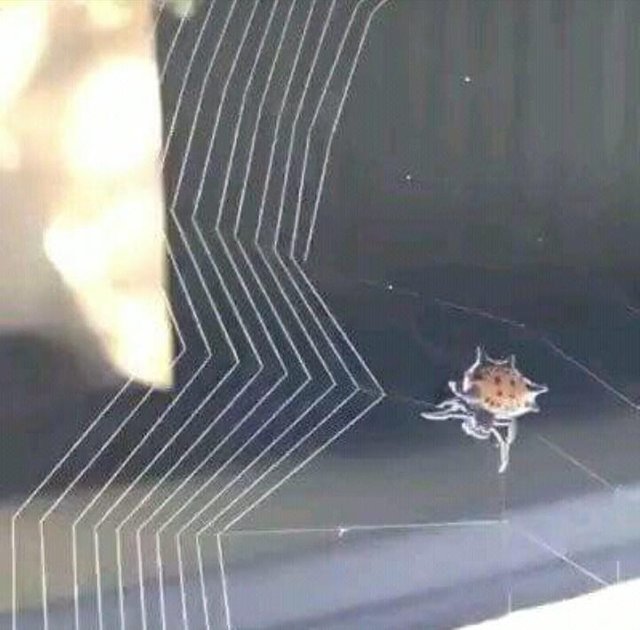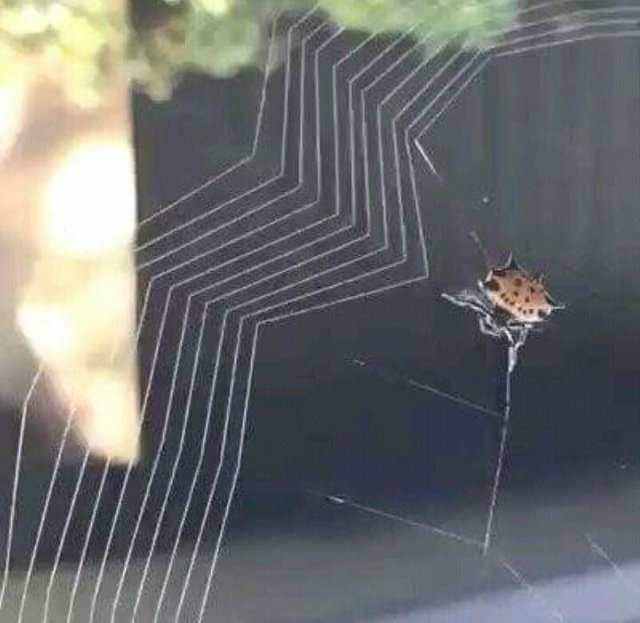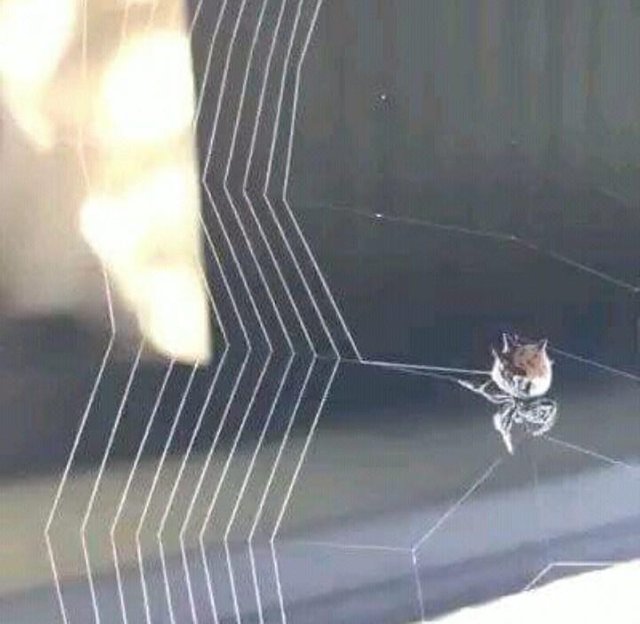Photo challenge _ How Does a Profit Make a Net?

Many of us really admire the way spiders make their nests. This award should be given to him, because in many ways when compared with other animals, the spider has its own special features. In our discussion this time we will reveal the facts about the interesting things about a spider. Spiders are everywhere regardless of the climate in their region. Spiders can live on water, on the ground, or even in the soil depending on the type of spider. Spider body sizes vary by type, ranging from three inches to almost invisible types of aliases. There are certain spiders that can live without water throughout the year. One type of spider, the giant spider called Tarantula, feeds on birds and can survive for up to 15 years. But most other types of spiders can only live for one year alone. Another thing that is also important to point out here is that the spider is not included in the group of insects. The spider belongs to a group of animals called Arachnids that differ entirely from insect groups. Because the spider has eight legs, the spider generally has eight eyes, a spiderless spider and a spider's body consists of only two parts.
The silk threads produced by spiders are useful for building their nests produced from homemade materials. The material is removed from certain glands from within the stomach. The molten substance of the silk thread is allowed to pass through the small holes of the yarn braid lying on the tip of the stomach. The threads first come out in liquid form, which then becomes hard after exposure to air.
There are many types of silk threads that spiders can produce. ie silk threads that contain adhesive properties useful for catching prey, There is also a type of silk thread that is slippery and does not contain an adhesive material that serves as the spiderweb building's caterpillars and there is also a silk thread that produced a functioning spider to make cocoons for the spider's eggs, some of which are delicate and soft and partly strong and tough.
Spiders make various networks for their nest. A circular network of special cases is made to catch prey. Firstly, a strong yarn network with an irregular triangular pattern on the outer side serves as the foundation of the spider's web. After that it was made a rig at the network's wheel pattern, followed by a spiral network arrangement of three or four levels. In the tight-edged network that contains adhesives to catch prey.
Another type of spider web is the type of sheet net, because the model is shaped flat sheet building, there is also a form of a funnel or dome. In such spider webs the spider walks with its backside upside down while clinging to its nest webs.
"Spider webs are more durable and elastic than the strongest man-made fibers, Kevlar, used in bulletproof vests," says evolutionary zoologist and spider webs Fritz Vollrath at the University of Aarhus, Denmark.
According to professor emeritus of mechanical engineering John Lienhard at the University of Houston, cobwebs are also very flexible, can even stretch 140% of the original length without breaking. For such mighty materials, spider webs are very light.
According to a book published in 2007 "The Book of Animal Ignorance: Everything You Think You Know Is Wrong," a web circling around the Earth is only about as much as a bar of soap. Spiny fiber protein spun spider has many uses. When the baby spider hatches from the egg, the baby releases its own net and patiently waits for it to be carried to the wind and spread to a new location, a process known as a 'balloon'. When the spider's baby lands, it will make a net to catch the insects to eat. According to assistant professor of entomology Linda Rayor at Cornell University, some species of spiders prefer to make small webs between legs and pounce on insects. It just takes a bit of time and energy than creating a big, complicated web.
Some spiders also use nets to create protective nests or cocoons, and those that use them to travel a few meters take advantage of the wind. There are also spiders that recycle their webs after they are not used. Scientists have long tried to understand the mechanisms of how spiders make webs, and so far efforts to create silk in the laboratory often fail. What makes the web difficult to create artificially is, complex protein molecules and repetitive DNA sequences. However, scientists understand how the web hardens in the spider. Vollrath discovered that the spider passed it by acidifying it, a method similar to the process of making industrial fibers such as nylon. After examining the channel in the spider, Vollrath stated, before entering the channel, the net consists of a liquid protein. According to Vollrath's article in Nature, when fluid enters the channel, the cells draw water from the net and hydrogen proteins are pumped to other parts of the duct and produce an acid bath. As a result, unbranded webs change from gel to solid fiber through spinneret spider acid glands. Spiders have 2-8 spinerets, depending on the species. The Spineret emits various types of webs, from sticky ones to not, depending on the time it takes the spider.
Here's how spiders create webs:

Foundation Horizontal
- The first and most difficult thing is to spread horizontal foundation threads like a suspension bridge without a supporting pole. To do so, does he fly or jump? Or throw a lasso rope like a cowboy? Or was he walking down? No, it was like flying a kite, he sprayed a long enough thread and rely on the wind to tether its sticky end to the opposite point.
In this process it can be said the spider uses pilot navigation skills that take into account the three basic elements of mileage, wind speed and altitude altitude.
Radius Center Point
- After unfolding the horizontal foundation yarn, it then builds the center point of the radius by finding the lowest swing point of the foundation yarn. From that point he then pulls it vertically by hooking a thread and descending vertically down to the bottom base forming the letter "Y".
It can be said that in this process the spider uses trigonometric calculations.
Perimeter Building
- Once the center is created, the spider then builds the perimeter of the outermost foundation, depending on its environmental conditions, may be rectangular, pentagonal, hexagonal, or octagonal, etc.
In this process it can be said that the spider has the same expertise with commandos in securing the perimeter around it.
Symmetrical Fingers
- After the perimeter of the foundation is formed, then he builds the foundation of the inner space by arranging the symmetrical fingers by knitting the threads from the center point to the perimeter of the foundation or vice versa to form the fingers as we see in the bicycle fingers.
Symmetrical nets are useful for isolating damage to certain sectors in the net or in other words if one of the broken threads does not affect the stability of the entire web.
Spiral Nets
- After the foundation fingers are awakened, the spider begins to build a spiral net that starts from the radius center point to the perimeter of the foundation. In general, the pattern of motion is similar to a galaxy or rotation of planets in the solar system, can even be said to be similar to the Thawaf round in Mecca.
Spiral net other than as a trap net, also serves as a water trap for the spider.
Stabilimentum
- If the trap webs that he made were in the path of minimal prey, then the spider will make Stabilimentum an additional ornamental net that serves to lure prey. The shape of the ornament Stabilimentum varies depending on the prey around it can be patterned like a flower or a small insect that can lure prey to come to him.

hopefully post about how the profit profit makes this net can be useful for us all ... !!!
➜@bible.com
Nice Picture munawir1994 ! :D
We would love to invite you to our Discord server.
In here we have more artists for you to connect to and
the ability to promote yourself and your blogs. Keep on Steemin my friend !
http://discord.gg/B6CxGGS
Congratulations! This post has been upvoted from the communal account, @minnowsupport, by zein from the Minnow Support Project. It's a witness project run by aggroed, ausbitbank, teamsteem, theprophet0, someguy123, neoxian, followbtcnews, and netuoso. The goal is to help Steemit grow by supporting Minnows. Please find us at the Peace, Abundance, and Liberty Network (PALnet) Discord Channel. It's a completely public and open space to all members of the Steemit community who voluntarily choose to be there.
If you would like to delegate to the Minnow Support Project you can do so by clicking on the following links: 50SP, 100SP, 250SP, 500SP, 1000SP, 5000SP.
Be sure to leave at least 50SP undelegated on your account.